SIM868_Hardware_Design_V1.01
�
Smart Machine Smart Decision
Document Title
SIM868 Hardware Design
Version
Date
Status
V1.01
2016-08-01
Release
Document Control ID
SIM868_Hardware_Design_V1.01
General Notes
SIMCom offers this information as a service to its customers, to support application and engineering efforts that
use the products designed by SIMCom. The information provided is based upon requirements specifically
provided to SIMCom by the customers. SIMCom has not undertaken any independent search for additional
relevant information, including any information that may be in the customer’s possession. Furthermore, system
validation of this product designed by SIMCom within a larger electronic system remains the responsibility of the
customer or the customer’s system integrator. All specifications supplied herein are subject to change.
Copyright
This document contains proprietary technical information which is the property of SIMCom Limited, copying of
this document and giving it to others and the using or communication of the contents thereof, are forbidden
without express authority. Offenders are liable to the payment of damages. All rights reserved in the event of grant
of a patent or the registration of a utility model or design. All specification supplied herein are subject to change
without notice at any time.
Copyright © Shanghai SIMCom Wireless Solutions Ltd. 2016
SIM868_Hardware_Design_V1.01 2 2016-08-01
�
Smart Machine Smart Decision
Contents
1.
Introduction .......................................................................................................... 8
2. SIM868 Overview ................................................................................................ 8
SIM868 ................................................................................................................................. 9
2.1.
SIM868 Key Features ........................................................................................................... 9
2.2.
2.3. Operating Mode .................................................................................................................. 11
2.4.
Functional Diagram............................................................................................................. 12
3. Package Information ......................................................................................... 14
3.1.
3.2.
3.3.
Pin Out Diagram ................................................................................................................. 14
Pin Description .................................................................................................................... 14
Package Dimensions ........................................................................................................... 17
4. Application Interface ......................................................................................... 20
4.1.
4.2.
4.3.
4.4.
4.5.
Power Supply ...................................................................................................................... 20
4.1.1. Power Supply Pin ................................................................................................................................ 21
4.1.2. Monitoring Power Supply ................................................................................................................... 22
Power on/off SIM868.......................................................................................................... 22
4.2.1. Power on SIM868 ............................................................................................................................... 22
4.2.2. Power off SIM868 ............................................................................................................................... 23
Power Saving Mode ............................................................................................................ 24
4.3.1. Minimum Functionality Mode ............................................................................................................ 24
4.3.2. Sleep Mode 1 (AT+CSCLK=1) .......................................................................................................... 25
4.3.3. Wake Up SIM868 from Sleep Mode 1 ................................................................................................ 25
4.3.4. Sleep Mode 2 (AT+CSCLK=2) .......................................................................................................... 25
4.3.5. Wake Up SIM868 from Sleep Mode 2 ................................................................................................ 25
Power Saving Mode ............................................................................................................ 26
Serial Port and USB Interface ............................................................................................. 26
4.5.1
Function of Serial Port ........................................................................................................................ 27
4.5.2
Serial Interfaces ................................................................................................................................... 28
4.5.3 Debug Interface ................................................................................................................................... 29
4.5.4
Software Upgrade ................................................................................................................................ 30
4.6. UART1_RI Behaviors ......................................................................................................... 31
4.7. Audio Interfaces .................................................................................................................. 32
4.7.1. Speaker Interfaces Configuration ........................................................................................................ 33
4.7.2. Microphone Interfaces Configuration ................................................................................................. 33
4.7.3. Audio Electronic Characteristic .......................................................................................................... 33
4.7.4. TDD .................................................................................................................................................... 34
SIM Card Interface.............................................................................................................. 34
4.8.1. SIM Card Application ......................................................................................................................... 34
4.8.2. SIM Card Design Guide ...................................................................................................................... 36
4.8.3. Design Considerations for SIM Card Holder ...................................................................................... 36
SD Interface ........................................................................................................................ 38
4.8.
4.9.
SIM868_Hardware_Design_V1.01 3 2016-08-01
�
Smart Machine Smart Decision
4.10.
I2C Bus ............................................................................................................................... 38
4.11. ADC .................................................................................................................................... 38
4.12. Network Status Indication ................................................................................................... 39
4.13. Operating Status Indication ................................................................................................. 40
4.14. RF Synchronization Signal ................................................................................................. 40
4.15. GNSS .................................................................................................................................. 40
4.15.1. GNSS Overview .............................................................................................................................. 40
Power on/down GNSS ..................................................................................................................... 41
4.15.2.
4.15.3.
1PPS Output..................................................................................................................................... 41
4.16. Antenna Interface ................................................................................................................ 41
4.16.1. GSM Antenna Interface ................................................................................................................... 41
4.16.2. GNSS Antenna Interface .................................................................................................................. 42
5. PCB Layout ........................................................................................................ 44
5.1
5.2
Pin Assignment ................................................................................................................... 44
Principle of PCB Layout ..................................................................................................... 45
5.2.1 Antenna Interface ................................................................................................................................ 45
5.2.2
Power Supply ...................................................................................................................................... 45
5.2.3
SIM Card Interface .............................................................................................................................. 45
5.2.4 Audio Interface.................................................................................................................................... 45
5.2.5 Others .................................................................................................................................................. 45
6. Electrical, Reliability and Radio Characteristics ........................................... 46
6.1
6.2
6.3
6.4
6.5
6.6
6.7
6.8
6.9
Absolute Maximum Ratings ............................................................................................... 46
Recommended Operating Conditions ................................................................................. 46
Digital Interface Characteristics .......................................................................................... 46
SIM Card Interface Characteristics ..................................................................................... 47
SIM_VDD Characteristics .................................................................................................. 47
VDD_EXT Characteristics ................................................................................................. 47
Current Consumption(VBAT=4.0V) ............................................................................. 47
Electro-Static Discharge ..................................................................................................... 48
Radio Characteristics .......................................................................................................... 49
6.9.1 Module RF Output Power ................................................................................................................... 49
6.9.2 Module RF Receive Sensitivity ........................................................................................................... 50
6.9.3 Module Operating Frequencies ........................................................................................................... 50
7. Manufacturing ................................................................................................... 51
7.1.
Top and Bottom View of SIM868 ...................................................................................... 51
7.2.
Typical Solder Reflow Profile ............................................................................................ 51
7.3.
The Moisture Sensitivity Level ........................................................................................... 52
7.4. Baking Requirements .......................................................................................................... 52
8. Appendix ............................................................................................................. 53
I.
II.
III.
Related Documents ............................................................................................................. 53
Terms and Abbreviations .................................................................................................... 54
Safety Caution ..................................................................................................................... 56
SIM868_Hardware_Design_V1.01 4 2016-08-01
�
Smart Machine Smart Decision
Table Index
TABLE 1: MODULE INFORMATION ............................................................................................................................. 9
TABLE 2: SIM868 KEY FEATURES ................................................................................................................................ 9
TABLE 3: GNSS ENGINE PERFORMANCE ................................................................................................................ 10
TABLE 4: CODING SCHEMES AND MAXIMUM NET DATA RATES OVER AIR INTERFACE ............................ 11
TABLE 5: OVERVIEW OF OPERATING MODES ........................................................................................................ 11
TABLE 6: PIN DESCRIPTION ....................................................................................................................................... 14
TABLE 7: RECOMMENDED ZENER DIODE .............................................................................................................. 20
TABLE 8: THE CURRENT CONSUMPTION OF FUNCTION MODE ........................................................................ 24
TABLE 9: SERIAL PORT AND USB PIN DEFINITION ............................................................................................... 27
TABLE 10: SERIAL PORT CHARACTERISTICS ......................................................................................................... 27
TABLE 11: USB_VBUS OPERATION VOLTAGE ........................................................................................................ 30
TABLE 12: RI BEHAVIORS ........................................................................................................................................... 31
TABLE 13: AUDIO INTERFACE DEFINITION ............................................................................................................ 32
TABLE 14: PERFORMANCE OF AUDIO AMPLIFIER ................................................................................................ 32
TABLE 15: MICROPHONE INPUT CHARACTERISTICS........................................................................................... 33
TABLE 16: AUDIO OUTPUT CHARACTERISTICS .................................................................................................... 34
TABLE 17: SIM PIN DEFINITION ................................................................................................................................. 34
TABLE 18: PIN DESCRIPTION (MOLEX SIM CARD HOLDER) .............................................................................. 36
TABLE 19: PIN DESCRIPTION (AMPHENOL SIM CARD HOLDER) ....................................................................... 37
TABLE 20: PIN DEFINITION OF THE I2C ................................................................................................................... 38
TABLE 21: PIN DEFINITION OF THE ADC ................................................................................................................. 38
TABLE 22: ADC SPECIFICATION ................................................................................................................................ 39
TABLE 23: PIN DEFINITION OF THE NETLIGHT ..................................................................................................... 39
TABLE 24: STATUS OF THE NETLIGHT PIN .............................................................................................................. 39
TABLE 25: PIN DEFINITION OF THE STATUS ........................................................................................................... 40
TABLE 26: DEFINITION OF THE RF_SYNC PIN........................................................................................................ 40
TABLE 27: RECOMMENDED TVS COMPONENT ..................................................................................................... 42
TABLE 28: ABSOLUTE MAXIMUM RATINGS........................................................................................................... 46
TABLE 29: DIGITAL INTERFACE CHARACTERISTICS ........................................................................................... 46
TABLE 30: SIM CARD INTERFACE CHARACTERISTICS ........................................................................................ 47
TABLE 31: SIM_VDD CHARACTERISTICS ................................................................................................................ 47
TABLE 32: VDD_EXT CHARACTERISTICS ............................................................................................................... 47
TABLE 33: CURRENT CONSUMPTION ...................................................................................................................... 47
TABLE 34: THE ESD CHARACTERISTICS (TEMPERATURE: 25℃, HUMIDITY: 45 %) ....................................... 48
TABLE 35: GSM850 AND EGSM900 CONDUCTED RF OUTPUT POWER .............................................................. 49
TABLE 36: DCS1800 AND PCS1900 CONDUCTED RF OUTPUT POWER ............................................................... 49
TABLE 37: CONDUCTED RF RECEIVE SENSITIVITY ............................................................................................. 50
TABLE 38: MOISTURE SENSITIVITY LEVEL AND FLOOR LIFE ........................................................................... 52
TABLE 39: BAKING REQUIREMENTS ....................................................................................................................... 52
TABLE 40: RELATED DOCUMENTS ........................................................................................................................... 53
TABLE 41: TERMS AND ABBREVIATIONS ................................................................................................................ 54
TABLE 42: SAFETY CAUTION ..................................................................................................................................... 56
SIM868_Hardware_Design_V1.01 5 2016-08-01
�
Smart Machine Smart Decision
Figure Index
FIGURE 1: SIM868 FUNCTIONAL DIAGRAM ........................................................................................................... 13
FIGURE 2: PIN OUT DIAGRAM (TOP VIEW) ............................................................................................................. 14
FIGURE 3: DIMENSIONS OF SIM868 (UNIT: MM) .................................................................................................... 17
FIGURE 4: RECOMMENDED PCB FOOTPRINT OUTLINE (UNIT: MM) ................................................................ 18
FIGURE 5: RECOMMENDED SMT STENCIL FOOTPRINT OUTLINE (UNIT: MM) .............................................. 19
FIGURE 6: REFERENCE CIRCUIT OF THE VBAT INPUT ......................................................................................... 20
FIGURE 7: REFERENCE CIRCUIT OF THE LDO POWER SUPPLY ......................................................................... 20
FIGURE 8: REFERENCE CIRCUIT OF THE DC-DC POWER SUPPLY ..................................................................... 21
FIGURE 9: VBAT VOLTAGE DROP DURING TRANSMIT BURST ........................................................................... 21
FIGURE 10: THE MINIMAL VBAT VOLTAGE REQUIREMENT AT VBAT DROP .................................................. 21
FIGURE 11: POWERED ON/DOWN MODULE USING TRANSISTOR ..................................................................... 22
FIGURE 12: POWERED ON/DOWN MODULE USING BUTTON ............................................................................. 22
FIGURE 13: TIMING OF POWER ON MODULE ......................................................................................................... 22
FIGURE 14: TIMING OF POWER OFF SIM868 BY PWRKEY ................................................................................... 23
FIGURE 15: TIMING OF RESTART SIM868 ................................................................................................................ 24
FIGURE 16: RTC SUPPLY FROM CAPACITOR ........................................................................................................... 26
FIGURE 17: RTC SUPPLY FROM NON-CHARGEABLE BATTERY ......................................................................... 26
FIGURE 18: RTC SUPPLY FROM RECHARGEABLE BATTERY .............................................................................. 26
FIGURE 19: CONNECTION OF THE SERIAL INTERFACES ..................................................................................... 28
FIGURE 20: RESISTOR MATCHING CIRCUIT ........................................................................................................... 28
FIGURE 21 : DIODE ISOLATION CIRCUIT ................................................................................................................. 29
FIGURE 22: TX LEVEL MATCHING CIRCUIT ........................................................................................................... 29
FIGURE 23: RX LEVEL MATCHING CIRCUIT ........................................................................................................... 29
FIGURE 24: USB REFERENCE CIRCUIT .................................................................................................................... 30
FIGURE 25: CONNECTION FOR SOFTWARE UPGRADING AND DEBUGGING .................................................. 30
FIGURE 26: CONNECTION FOR SOFTWARE UPGRADING AND DEBUGGING .................................................. 31
FIGURE 27: UART1_RI BEHAVIOUR OF VOICE CALLING AS A RECEIVER ....................................................... 31
FIGURE 28: UART1_RI BEHAVIOUR OF URC OR RECEIVE SMS .......................................................................... 32
FIGURE 29: UART1_RI BEHAVIOUR AS A CALLER ................................................................................................. 32
FIGURE 30: SPEAKER REFERENCE CIRCUIT .......................................................................................................... 33
FIGURE 31: MICROPHONE REFERENCE CIRCUIT .................................................................................................. 33
FIGURE 32: REFERENCE CIRCUIT OF THE 8-PIN SIM CARD HOLDER ............................................................... 35
FIGURE 33: REFERENCE CIRCUIT OF THE 6-PIN SIM CARD HOLDER ............................................................... 35
FIGURE 34: MOLEX 91228 SIM CARD HOLDER ...................................................................................................... 36
FIGURE 35: AMPHENOL C707 10M006 512 SIM CARD HOLDER ........................................................................... 37
FIGURE 36: SD REFERENCE CIRCUIT ....................................................................................................................... 38
FIGURE 37: REFERENCE CIRCUIT OF NETLIGHT .................................................................................................. 39
FIGURE 38: RF_SYNC SIGNAL DURING TRANSMIT BURST ................................................................................ 40
FIGURE 39: GSM ANTENNA MATCHING CIRCUIT ................................................................................................. 41
FIGURE 40: GSM ANTENNA MATCHING CIRCUIT WITHOUT RF CONNECTOR ............................................... 42
FIGURE 41: GNSS PASSIVE ANTENNA MATCHING CIRCUIT ............................................................................... 43
FIGURE 42: GNSS ACTIVE ANTENNA MATCHING CIRCUIT ................................................................................. 43
FIGURE 43: PIN ASSIGNMENT .................................................................................................................................... 44
FIGURE 44: TOP AND BOTTOM VIEW OF SIM868 ................................................................................................... 51
FIGURE 45: TYPICAL SOLDER REFLOW PROFILE OF LEAD-FREE PROCESS .................................................. 51
SIM868_Hardware_Design_V1.01 6 2016-08-01
�
Smart Machine Smart Decision
Version History
Date
Version
Description of change
2016-06-20
1.00
Origin
1. Update figure 1
2. Add voltage range of GPS_VBAT
3. Add voltage range of VRTC
4. Add voltage range of GNSS_EN
5. Add Recommenced SMT stencil footprint
2016-08-01
1.01
6. Delete Over-Temperature or Under- Temperature Power off
7. Change PWRKEY pin from at least 1 second to 1.5 second for
power off the module
8. Add GNSS software update part
9. Delete Multiplexing function
10. Add BPF component in GNSS part
Author
Yanwu.Wang;
Xiaoxu.Chen
Yanwu.Wang;
Xiaoxu.Chen
SIM868_Hardware_Design_V1.01 7 2016-08-01
�
Smart Machine Smart Decision
1. Introduction
This document describes SIM868 hardware interface in great detail. The document can help customer to quickly
understand SIM868 interface specifications, electrical and mechanical details. With the help of this document
and other SIM868 application notes, customer guide, customers can use SIM868 to design various applications
quickly.
2. SIM868 Overview
Designed for global market, SIM868 is integrated with a high performance GSM/GPRS engine and a GNSS
engine. SIM868 is a quad-band GSM/GPRS module that works on frequencies GSM 850MHz, EGSM 900MHz,
DCS 1800MHz and PCS 1900MHz. SIM868 features GPRS multi-slot class 12/class 10 (optional) and supports
the GPRS coding schemes CS-1, CS-2, CS-3 and CS-4.
The GNSS solution offers best-in-class acquisition and tracing sensitivity, Time-To-First-Fix (TTFF) and
accuracy. With built-in LNA, SIM868 doesn’t need external LNA. SIM868 can track as low as -167dBm signal
even without network assistance. The SIM868 has excellent low power consumption characteristic (acquisition
24mA, tracking 21mA). SIM868 supports various location and navigation applications, including autonomous
GPS, GLONASS, BEIDOU, QZSS, SBAS (WAAS, EGNOS, GAGAN, MSAS) and A-GPS.
With a tiny configuration of 17.6*15.7*2.3mm, SIM868 can meet almost all the space requirements in
customers’ applications, such as smart phone, PDA and other mobile devices.
SIM868 is a SMT+LGA package with 77 pads, and provides all hardware interfaces between the module and
customers’ boards.
One 3 lines serial port and one full modem serial port;
GNSS Serial port
USB interface which can be used for debugging and upgrading firmware;
Audio channels which include a microphone input and two speakers output;
Programmable general purpose input and output;
Two SIM cards interface;
Support GNSS function;
33tracking/99 acquisition-channel GNSS receiver
SD card interface;
I2C interface;
ADC interface.
SIM868 is designed with power saving technique so that the current consumption is as low as 0.65 mA in sleep
mode (with GNSS engine powered down).
SIM868 integrates TCP/IP protocol and extended TCP/IP AT commands which are very useful for data transfer
applications. For details about TCP/IP applications, please refer to document [2].
SIM868_Hardware_Design_V1.01 8 2016-08-01
�
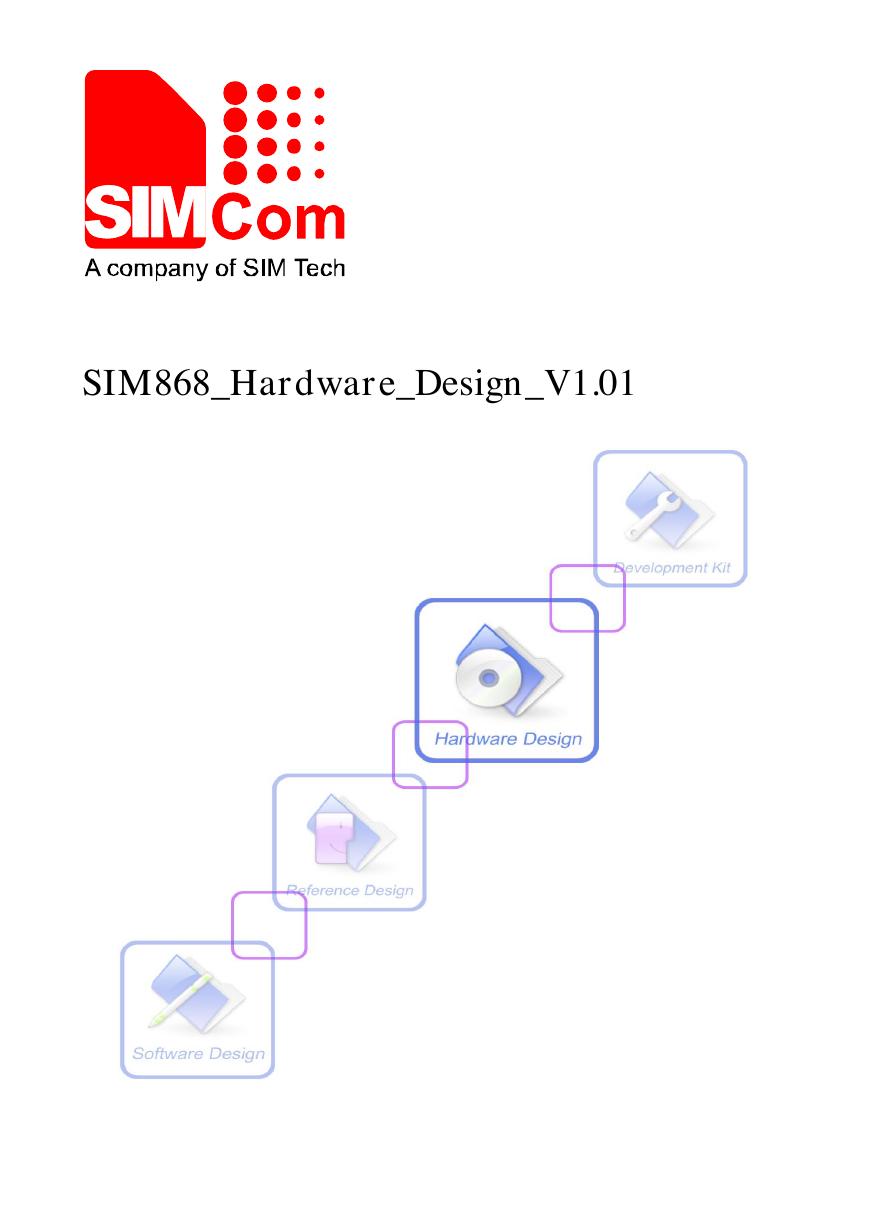
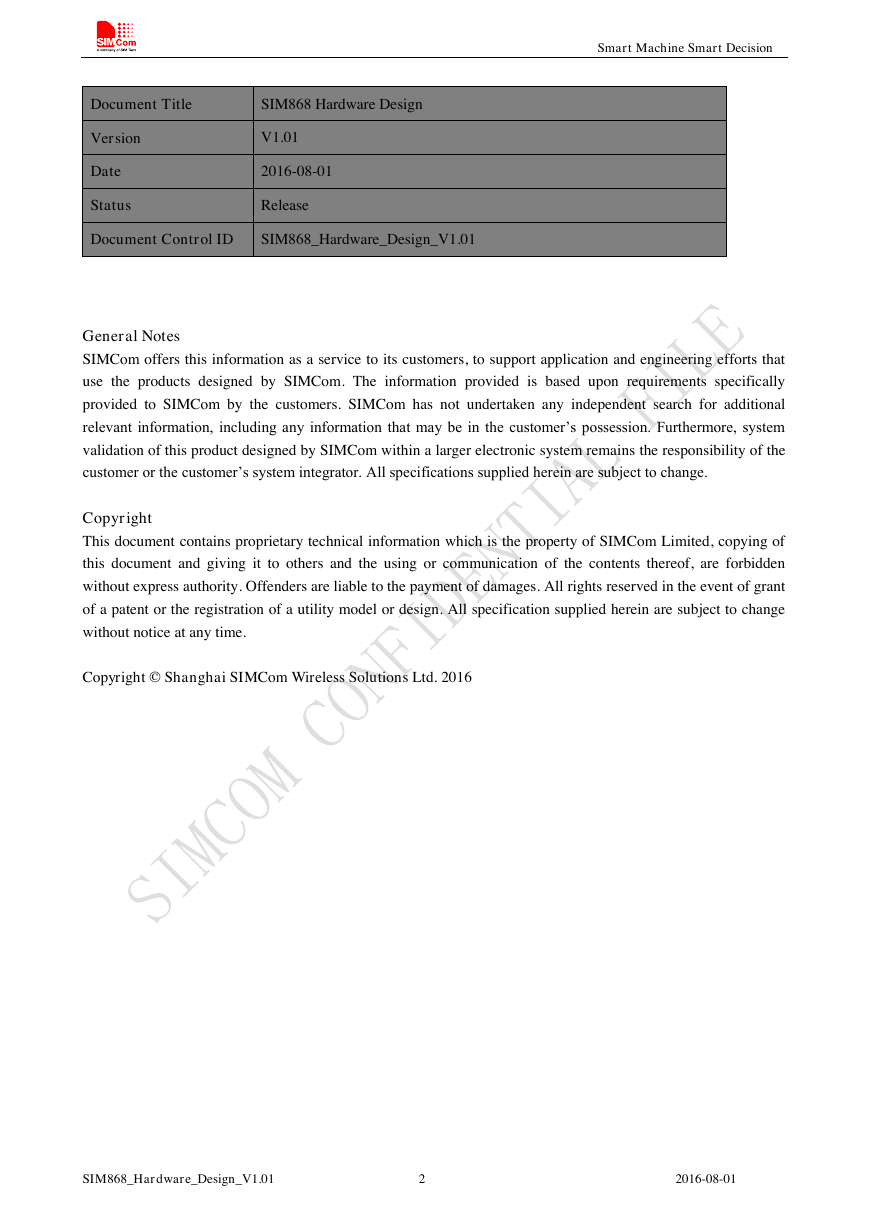



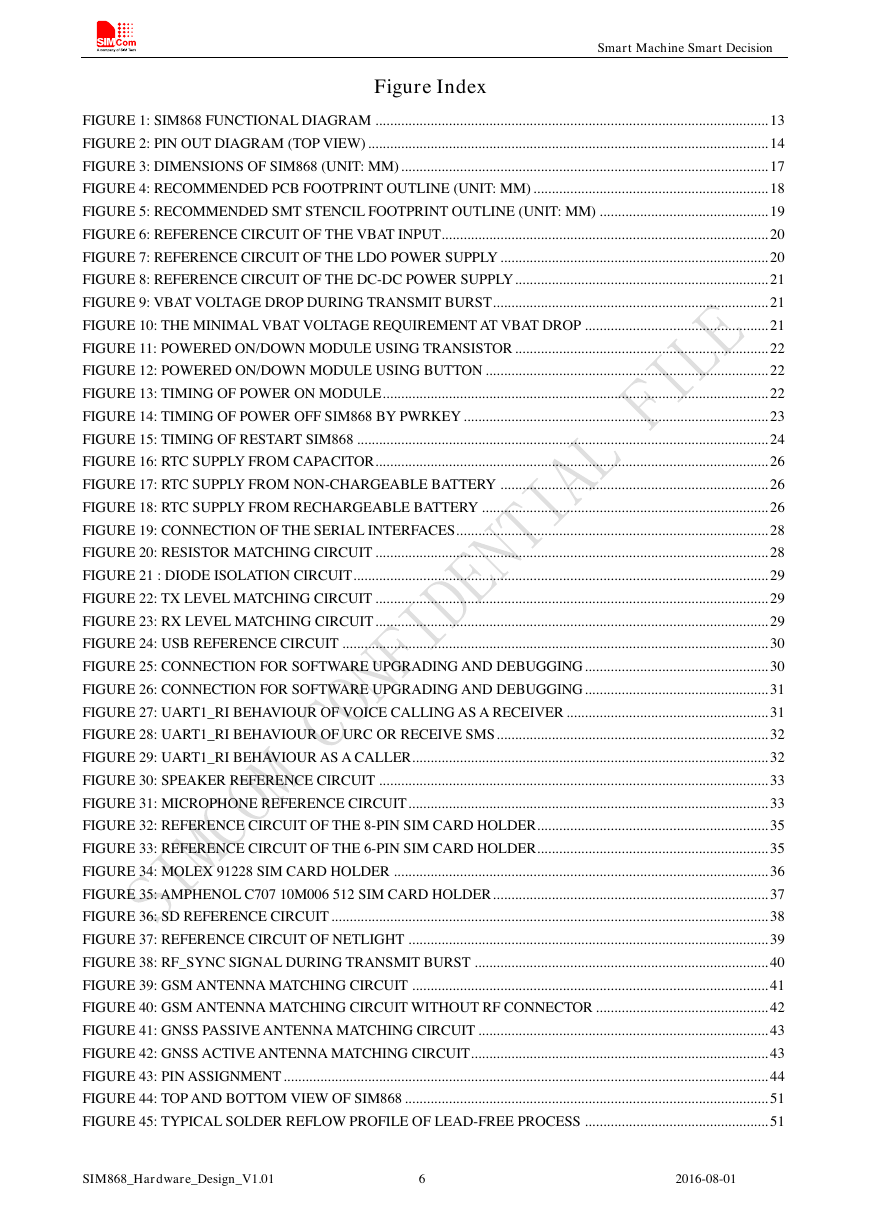
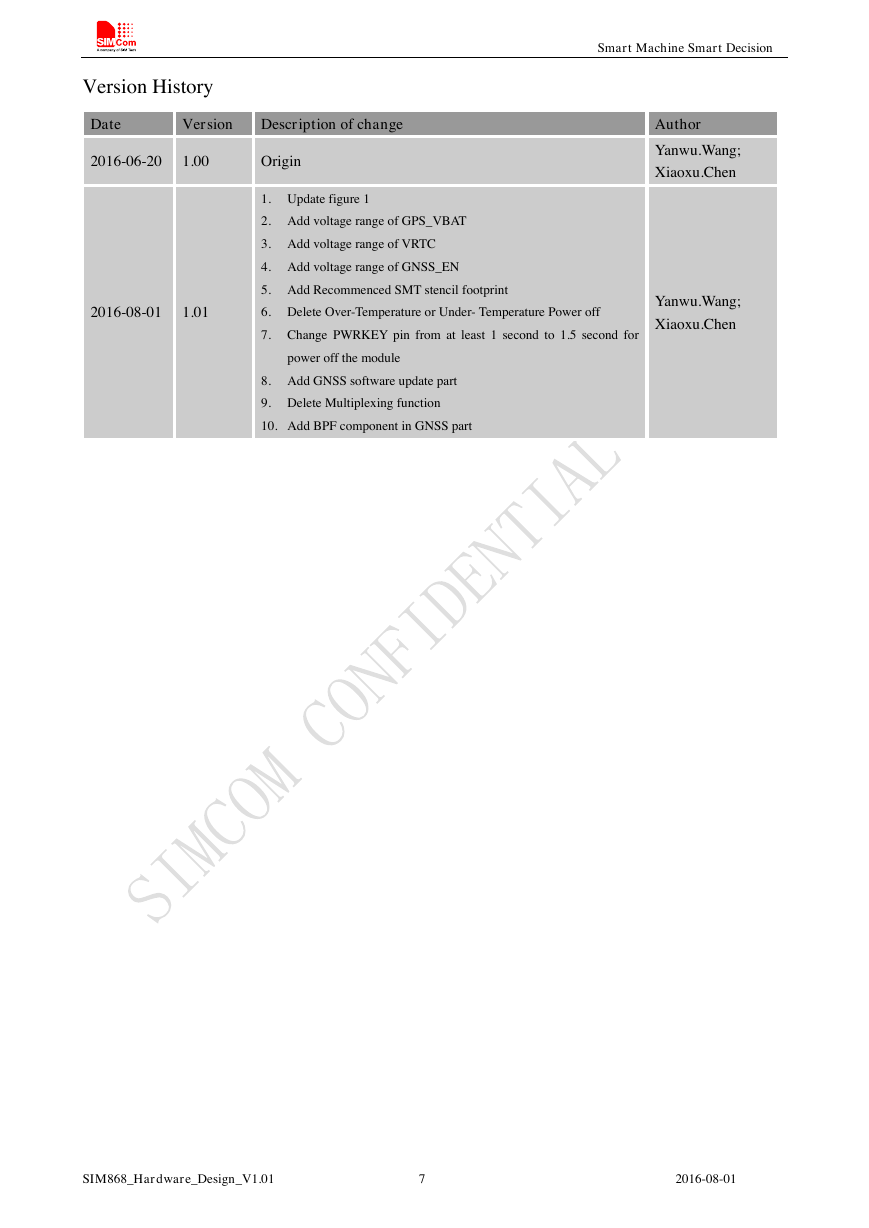
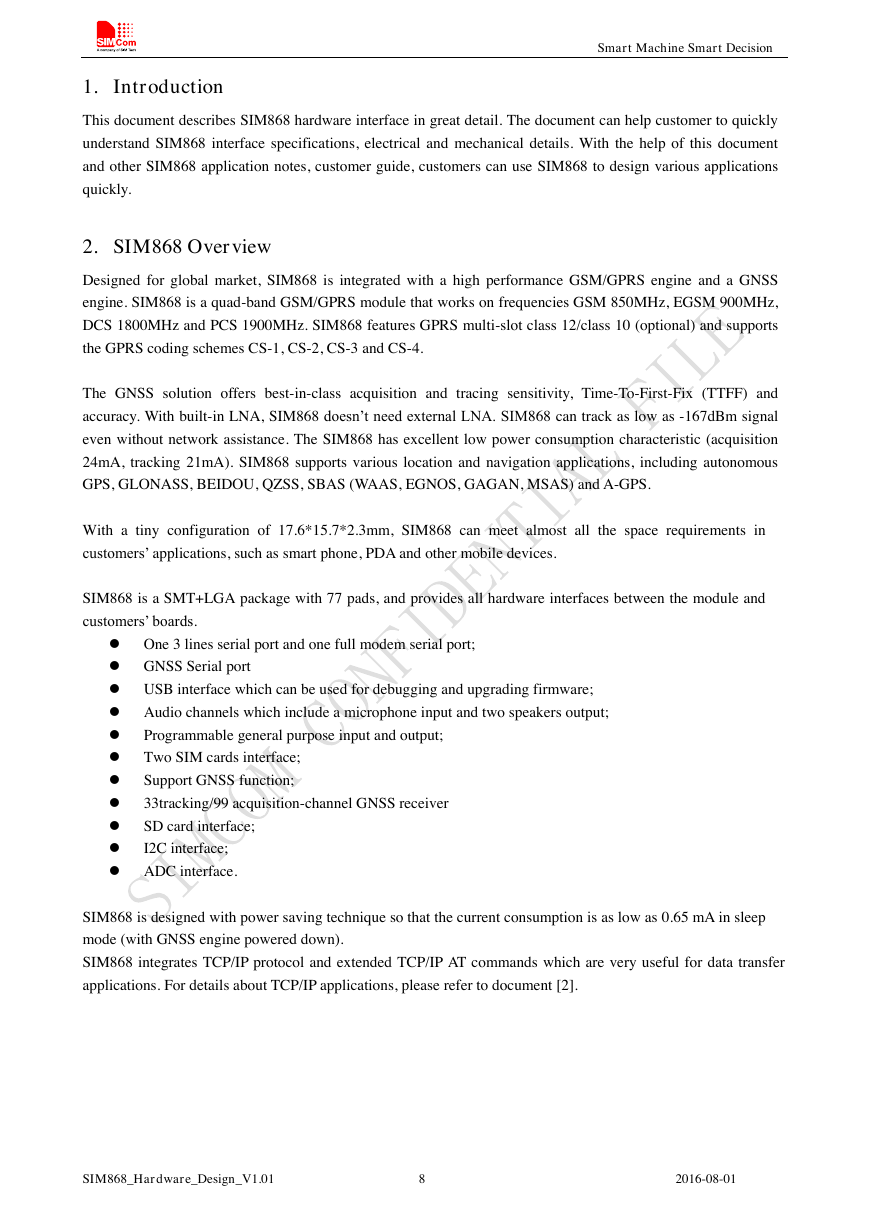








 2023年江西萍乡中考道德与法治真题及答案.doc
2023年江西萍乡中考道德与法治真题及答案.doc 2012年重庆南川中考生物真题及答案.doc
2012年重庆南川中考生物真题及答案.doc 2013年江西师范大学地理学综合及文艺理论基础考研真题.doc
2013年江西师范大学地理学综合及文艺理论基础考研真题.doc 2020年四川甘孜小升初语文真题及答案I卷.doc
2020年四川甘孜小升初语文真题及答案I卷.doc 2020年注册岩土工程师专业基础考试真题及答案.doc
2020年注册岩土工程师专业基础考试真题及答案.doc 2023-2024学年福建省厦门市九年级上学期数学月考试题及答案.doc
2023-2024学年福建省厦门市九年级上学期数学月考试题及答案.doc 2021-2022学年辽宁省沈阳市大东区九年级上学期语文期末试题及答案.doc
2021-2022学年辽宁省沈阳市大东区九年级上学期语文期末试题及答案.doc 2022-2023学年北京东城区初三第一学期物理期末试卷及答案.doc
2022-2023学年北京东城区初三第一学期物理期末试卷及答案.doc 2018上半年江西教师资格初中地理学科知识与教学能力真题及答案.doc
2018上半年江西教师资格初中地理学科知识与教学能力真题及答案.doc 2012年河北国家公务员申论考试真题及答案-省级.doc
2012年河北国家公务员申论考试真题及答案-省级.doc 2020-2021学年江苏省扬州市江都区邵樊片九年级上学期数学第一次质量检测试题及答案.doc
2020-2021学年江苏省扬州市江都区邵樊片九年级上学期数学第一次质量检测试题及答案.doc 2022下半年黑龙江教师资格证中学综合素质真题及答案.doc
2022下半年黑龙江教师资格证中学综合素质真题及答案.doc